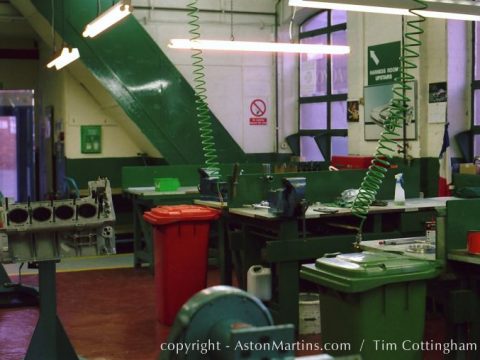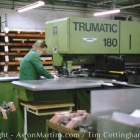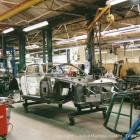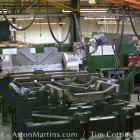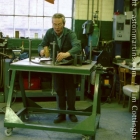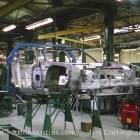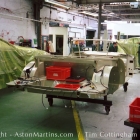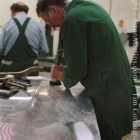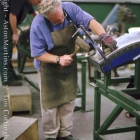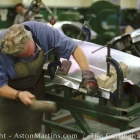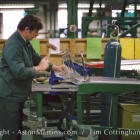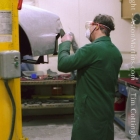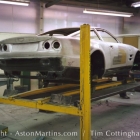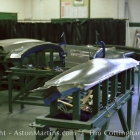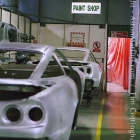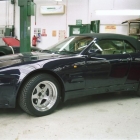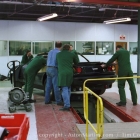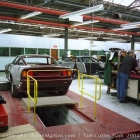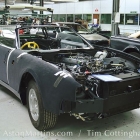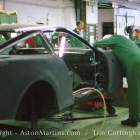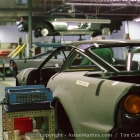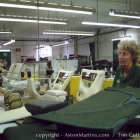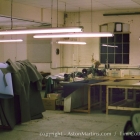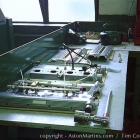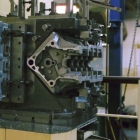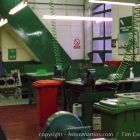Although these pictures were taken in the 1990’s it is important to remember that Aston Martin had been building cars in pretty much the same way since the DB4 in 1958. The strong platform chassis of the DB4/5/6 designed by Harold Beech, was widened for the DBS/DBSV8, lengthened for the Lagonda and again modified for the Virage. It’s hard to believe but their is a direct link between the DB4 and the 2000 V8 swb Vantage Volante. By the mid 1990’s, it was taking about 12 weeks to build a V8 model. Of the components that make a V8, a majority were made on site at Newport Pagnell – indeed a greater proportion of in-house parts than any other British manufacturer at that time. The cars were meticulously and extensively hand made which accounted for their very high purchase price. I am not in any way an engineer so I hope that the comments that I have made below are correct. If you wish to let me know of any faults, then please let me know.
Chassis Fabrication and the Press Shop.
The floor pan is made up of many parts of sheet and tubular steel which were manufactured on site in the press shop. These were assembled and welded on a series of jigs to an accuracy of 3mm. If you look carefully you can see the model and chassis numbers written on the floor pans in black magic marker. By the time that the car has been finished, the chassis number can be found stamped on many parts of the car. The chassis structure was given full electrocoat anti-corrosion treatment by being totally immersed in special paint whist having an electrical current passed through it.
The Panel Shop.
V8 Aston Martins were fitted with hand-formed aluminium panels painstakingly fitted to the chassis structure in the panel shop. Each piece is fabricated on a buck using traditional tools before being fitted. The noise of the hammering was so deafening , AM used to give out ear plugs to visitors, of even more importance, you can see that the employees wore them too.
The Paint Shop.
Aston Martin paint finishes are legendary. The paint on 1990’s V8s took 150 hours and comprised of 12 separate coats with hand finishing between coats. It was difficult to get pictures in this area as it was intended to be free of dust. After painting, the bodies were covered in polythene sheets to prevent the paint being damaged.
Final Assembly.
Once painted, the final assembly must be undertaken with great care so as not to damage the paintwork or aluminium body. As you can see, the delicate bodywork is protected by close fitting panels and even the door handles have tape to protect them from scratching by finger nails. Final assembly began with fitting the wiring and sound insulation. Then the front and rear suspension were added, brake and fuel lines, engine, transmission and rear axle. At this point, slave wheels were put on to enable the cars roll about the factory. Next came the cooling system, air-con, instruments, entertainment systems and interior controls. Then if the car is a Volante, the hood is fitted. Once all this has been done, the cars were fully checked over and then taken to the Millbrook Proving Ground for an exhaustive 70 mile road test. All this still on the slave wheels and with slave seats too to prevent damage.
The Trim Shop
The trim shop was located across the road from the main manufacturing area in a building that at one time had been a cinema. At this time, the factory claimed that it took 11 Connolly hides to trim each car, 10 for the car itself and one to be stored at the factory for later repair or restoration. Even with the relatively small number or cars being built at the time, it would have been impossible to store all the hides – just one of many almost true stories associated with the marque.
The Engine Shop.
The V8 is an extremely special engine. For in excess of 30 years, each and very one of the 5000 units were hand built at the factory, each by just a single engine builder. From the mid 1970’s, each engine received a special plate with the engine builders name on it. Whilst the rough castings of each engine were made outside of the factory, the machining was totally in-house. The engine builder selected and balanced the components before assembling the powerful unit, spending over a week on each one. There was no manual for the engine builders to follow and each had there own way of building them too. Just to give you some idea of the work involved in the handbuilt V8, AM quoted in the late 1980’s a figure of £20,000 for a replacement.
For a different view of Virage & Vantage production, try the website of the artist, Billy (David Bill) who was commissioned by Aston Martin during the 1990’s.
